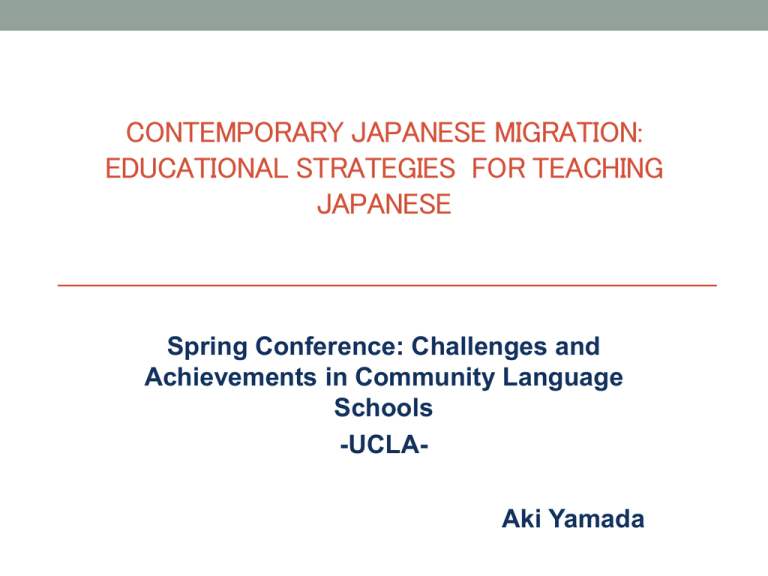Contemporary Japanese Migration: Educational Strategies for
advertisement

CONTEMPORARY JAPANESE MIGRATION: EDUCATIONAL STRATEGIES FOR TEACHING JAPANESE Spring Conference: Challenges and Achievements in Community Language Schools -UCLAAki Yamada New waves of Japanese Immigrants: Shin –Issei, or “New-First Generation” New Japanese began arriving during the post WWII Japanese economic boom, and continue to arrive today Different types of Japanese immigrants come to the US for varying purposes It is not likely that they migrate to the West in search of something “modern” Examples of modern Japanese abroad: language and academic study abroad, corporate sojourners, international marriage, immigrant entrepreneurs, etc… Living in a globalized era, what educational strategies do new Japanese immigrant parents utilize? Do they raise their children transnationally and/or bilingually? What role do supplementary schools play for contemporary Japanese parents? How does globalization directly impact education strategies? Diversity of “Shin-Issei” sub-groups Study abroad, Internation al marriage Different educational strategies exist for each subgroup Private busines s Profession al workers, sojourners →Depending on their status and purpose, “Shin-Issei” immigrants adjust their educational strategies for their 2nd generation children. Definition of Japanese School How do the supplementary schools differ? Examples of Japanese schools in LA (Diverse!!!) • Different type (Curriculum/Purpose) of Japanerse schools. Large, centralized communities are able to support special educational institutions for both sojourners and non-sojourners. On-site observation of Japanese language schools Oral-historical interviews of Japanese parents raising children in the United States Conduct survey questionnaire Interviews with Americanborn 2nd generation college students Two major education strategies Sojourners (Kikoku gumi 帰国組) • Japanese school on the weekend • Supplementary school • Schools designed to prepare students for the Japanese education system • Japanese cram school (Jyuku) Non-sojourners (Eijyu Gumi 永住組) • Japanese school on weekend (specific campus) • Standard American public school • Learn Japanese at home • Might not attend any heritage language/ supplementary school Japanese Parents’ expectations for supplementary schools • To serve as a center for fostering and sharing ethnic • • • • • values and identity Acquiring language through the process of sociocultural knowledge Parents networking, information resources Offer opportunity for Japanese ethnic group membership Multi-dimensional role, not limited to language Supplementary school has organized support and advice regarding education (educational path, next stage of education) Outside supplementary school -voices from Japanese parents• Not only sending their children to Japanese supplementary school, but Japanese mothers played an extra role in teaching Japanese to their children (ex: Japanese writing, mathematic solving questions, essays) • Watching Japanese children cartoons, movie in order to improve listening skills • Large amount of homework assignments • Engaging their children with Japanese pop-culture, anime, cartoon, comics book • Some return to Japan during the summer in order to let their children attend school in Japan • Formal Japanese was hard for children to learn • The majority of Shin-Issei immigrants want their children to study Japanese in the supplementary school, regardless of their status as sojourners or non-sojourners • Language schools are not the only place to learn Japanese language • Japanese parents, regardless of their plans to return, see transnationality as a valuable asset in the new global economy • Through interviews with Japanese mothers, expectations and definitions of being bilingual were quite different








